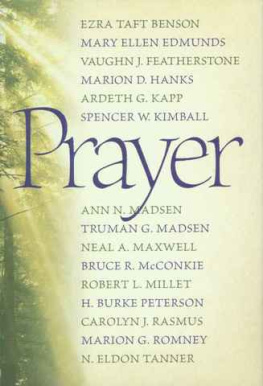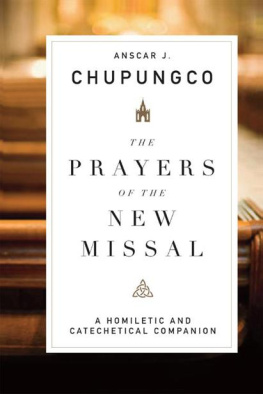MAXIMIZING THE MASS
How to Live Liturgical Prayer with all Your Heart and Mind
Fr. Nikola Derpich, L.C., S.Th.D.
Copyright 2020 RCSpirituality Center
Liturgical prayers, as well as texts from the General Instruction of the Roman Missal, are taken from The Roman Missal, United States Conference of Catholic Bishops, Washington, D.C., 2011, Third Typical Edition.
Excerpts from the English translation of The Roman Missal 2010, International Commission on English in the Liturgy Corporation. All rights reserved.
Scriptural passages taken from The Holy Bible: Revised Standard Version, Catholic Edition, National Council of Churches of Christ in the USA, New York, 1994; and New American Bible, United States Conference of Catholic Bishops, Washington, D.C., 2011, Revised Edition.
Catechism texts taken from Catechism of the Catholic Church, Libreria Editrice Vaticana, Vatican City, 1997, Second Edition.
Other Magisterial texts taken from https://www.vatican.va.
Cover design by Coronation Media.
ISBN: 9781661265496
Digital book(s) (epub and mobi) produced by Booknook.biz.
TABLE OF CONTENTS
INTRODUCTION
A typical smartphone has multiple communication technologies incorporated into its designWi-Fi, a cellular network, Bluetooth, USB, etc.and is surrounded by a world bristling with information and looking to establish a connection. Its often a challenge to harness the power of those technologies and capitalize on everything that can be communicated.
In the liturgy something similar occurs: the liturgy seeks to communicate on various levels with symbols, Scripture, prayers, gestures, and rites, but, most importantly, grace, and its a challenge to draw all the spiritual fruit we can from not just attending the Mass, but participating in it. Its a world of spiritual goods just waiting to be tapped into.
Since the Second Vatican Council the Church has endeavored to foster active participation in Mass among the faithful. As the first constitution of the Second Vatican Council, Sacrosanctum Conclium, described it:

But in order that the liturgy may be able to produce its full effects, it is necessary that the faithful come to it with proper dispositions, that their minds should be attuned to their voices, and that they should cooperate with divine grace lest they receive it in vain (cf. 2 Cor 6:1). Pastors of souls must therefore realize that, when the liturgy is celebrated, something more is required than the mere observation of the laws governing valid and licit celebration; it is their duty also to ensure that the faithful take part fully aware of what they are doing, actively engaged in the rite, and enriched by its effects (SC 11; see SC 14ff.).
Pope Benedict XVI in the post-synodal exhortation Sacramentum Caritatis noted that this active participation was not just a matter of doing something during Mass, but of something more profound:

The Second Vatican Council rightly emphasized the active, full and fruitful participation of the entire People of God in the eucharistic celebration. Certainly, the renewal carried out in these past decades has made considerable progress towards fulfilling the wishes of the Council Fathers. Yet we must not overlook the fact that some misunderstanding has occasionally arisen concerning the precise meaning of this participation. It should be made clear that the word participation does not refer to mere external activity during the celebration. In fact, the active participation called for by the Council must be understood in more substantial terms, on the basis of a greater awareness of the mystery being celebrated and its relationship to daily life (Sacramentum Caritatis, 52).
The goal of this book is to help you make a vital connection in Mass to help you put heart and mind more fully into your liturgical prayer and capitalize on all the graces it seeks to communicate. It contains a spiritual reflection on prayers from the Ordinary of the Mass: the liturgical prayers we say daily or every Sunday when the Mass is celebrated, from the entrance to the dismissal.
How to Use This Book
The goal of this book is not to distract you during Mass. You shouldnt be juggling this book in one hand while juggling a Missalette in the other during the celebration of the Eucharist. It is also not to describe or explain the Mass, although some explanations are included. This book is a spiritual resource. Its main purpose is to help you delve deeper spiritually into the prayers we say during Mass and put your heart more fully into your liturgical prayer.
This is a resource to use before Mass. Each meditation is on a liturgical prayer recited in Mass, so it is helpful to have a Missalette or small Roman Missal handy and have access to the complete text of the liturgical prayers. Having a Missal will guarantee you have all the prayers mentioned in this book, since Missalettes and other resources like Magnificat are necessarily abridged to save space.
If youd like to do a meditative walk through the Mass from start to finish, including Eucharistic Prayer III, the first part of this book, entitled Let us Pray, is for you. You can also go to specific Mass moments in this part, which goes through the Mass prayers in chronological order.
The second part of this book, entitled Make holy these gifts, we pray, contains mediations on Eucharistic Prayer I (also known as the Roman Canon) and Eucharistic Prayer II, each from start to finish. If you start directly with this part you might want to read the meditations and explanations on .
The third part of this book, entitled always and everywhere to give you thanks , contains meditations on the Prefaces used at the start of the Eucharistic Prayers, which vary based on liturgical season, occasion, and topic. If you start directly with this part you might want to read the meditations and explanations on .
If you want to meditate on prayers regarding specific mysteries of the life of Christ, such as Christmas and Easter, liturgical seasons, such as Advent and Lent, or topics such as the Saints, the Blessed Virgin Mary, etc., this part of the book is for you.
I hope this book helps you achieve a greater awareness of the mystery being celebrated and its relationship to daily life (Sacramentum Caritatis, 52).
PART I:
Let us Pray
A meditative walk through the Mass, from Entrance to Dismissal
INTRODUCTORY RITES
One of the most elemental meanings of the word introduction is to lead into something. The Introductory Rites are the entrance into liturgical prayer. They help us to disconnect from distractions, to change gears, and to enter into the correct mood and disposition for the occasion or season being celebrated.
The Entrance
In the entrance the people gather and either sing a liturgical chant or recite the Entrance Antiphon as the priest or bishop enters and processes to the altar. The General Instruction of the Roman Missal (found at the beginning of the Roman Missal) says the goal of the Entrance Chant is to open the celebration, foster the unity of those who have been gathered, introduce their thoughts to the mystery of the liturgical time or festivity, and accompany the procession of the Priest and ministers (n.47). Even when the faithful dont sing the Entrance Chant, it is said by the priest, or he makes some opening remarks to lead into the celebration (n.48; cf. n.31).
A LITURGICAL MOMENT OF YOUR LIFE IS BEGINNING
Your life, liturgically and otherwise, is unified. Changing gears in order to enter into liturgical prayer can be daunting. The important thing is to live the liturgy as an important moment of your life.
Next page








